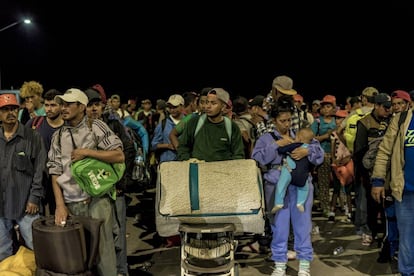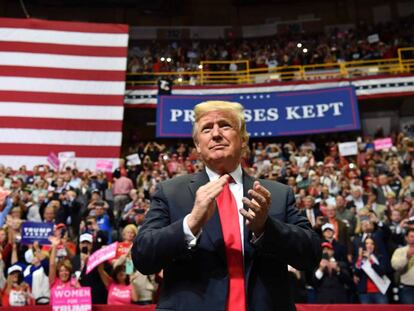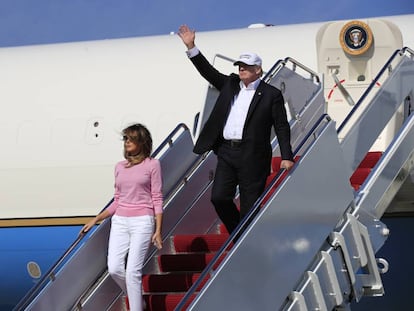Mexico negotiating “Marshall Plan” with Trump to combat Central American migration
The government of López Obrador is backing a project that will see migrants assimilated in Mexico and the US incentivize private investment in the south of the country
Faced with the caravans of migrants who are traveling through the country headed to the United States, the incoming Mexican government has admitted that for now, a containment policy is not viable. In a bid to find a solution to the phenomenon, the administration of Mexican President Andrés Manuel López Obrado, who will be sworn in to his role next Saturday, is negotiating a kind of “Marshall Plan” for Central America. Sources from the Mexican Chancellery with knowledge of the conversations say that the aim is to achieve a paradigm shift as well as to increase investment in the south of the country, with the help of the United States, which will also boost assistance to countries in the north triangle of Central America and increase the flexibility of the administrative processes for migrants in Mexico. The goal is for the deal to be done by May at the latest, so that it produces tangible results in 2020.

With US President Donald Trump ever more belligerent against the wave of migrants arriving at the northern border of Mexico, López Obrador has proposed a change of policy to address an unstoppable phenomenon that is feared to become a new problem of internal security. The future administration is trying to reach a deal with the United States whereby Mexico will take in the migrants who want to request asylum in their territory, for as long as the process lasts. Sources consulted by EL PAÍS say that so far no procedure has been established and that it is a plan that will not just affect the northern border with Mexico. The same sources argue that, in practice, this is something that is already happening. The government of López Obrador calculates that there are currently around 9,000 migrants stranded at the border, a number that no doubt will increase as the months pass.
The objective is to secure more than $20 billion during the six-year presidential term
In exchange, Mexico is looking to secure a double commitment on the part of the government of Donald Trump. According to information EL PAÍS has secured from sources at the Secretariat of Foreign Affairs and from one of the Central American governments involved, the plan includes a development and investment plan with the United States in the south of Mexico, the area of the country that has been most forgotten. The objective, according to these sources, is to secure more than $20 billion during the six-year presidential term, mainly in private investment, with the agreement or the promotion of the United States. Sources consulted for this story believe that Trump is not displeased with this plan, although they are aware that they will also have to deal with the toughest branch of the administration, the one that is in favor of the construction of a border wall, and that considers that the migration crisis is not an issue for the United States. On Sunday, Trump added fuel to the fire by insisting that Mexico should be “intelligent” and put a stop to the migrant caravans.

What’s more, the plan includes the United States increasing aid to the countries in the northern triangle of Central America. Until now, $600 million has been allocated to the Central America Prosperity Project, which was born out of the migrant children crisis in 2014, but in practice only $200 million was received. The other $400 million never arrived, mainly due to the complex way in which the United States Agency for International Development (USAID) operates. According to the plan that Mexico has put on the table for the United States, and about which the Central American governments are aware, the aid will rise to $1.5 billion. The conversations, which have been taking place since September and are headed up by the future foreign affairs secretary, Marcelo Ebrard, should come to fruition between December and May of the coming year, the sources consulted explain, so that the investments will start to materialize between 2019 and 2020. Otherwise, the whole plan could founder.
The government of López Obrador trusts that it will be able to absorb a large part of the nearly 200,000 migrants who cross through Mexico every year headed for the United States. The model will have two strands. The internal one is related to the so-called “development curtains” that the new government wants to establish from Chiapas, in the south of the country and one of the most underdeveloped areas of the country, to the country’s capital.
The “development curtains” will be the focal points of huge amounts of public investment in public works. Until now, López Obrador has been emphasizing three plans. One in Chiapas, which is related to the reforestation of the south of the country, a government plan which includes planting a million hectares of fruit trees and creating 400,000 jobs, according to the new head of state. The second focal point is the southeast of Mexico, where the construction of the so-called Mayan train is being planned. It’s a 1,500-kilometer rail line that will run through the states of Tabasco, Chiapas, Campeche, Yucatán and Quintana Roo. And the third major project will be another train, the “transistmico,” a rail line that will connect the Pacific (Oaxaca) with the Atlantic (Veracruz).
According to the Mexican government, there are currently around 9,000 migrants stranded at the border
The plan also includes an external facet, which will make the migratory administrative procedures more flexible to facilitate access to permits for Central Americans. The visa plan for foreign workers is inspired by the model put in place for Haitians in Brazil. According to sources from the Senate Foreign Committee, these will be “humanitarian visas” that last a year but that can be renewed. “Initially they will be grouped together in shelters, but once they start to have a fixed income they will be gradually moved to conventional housing,” sources explain.
Those who are more skeptical about the plan see it as an improved version of the Puebla Panama Plan, the free-trade area from Panama to the United States the former president, Vicente Fox (2000-2006), tried to implement, but that was abandoned due to a series of problems. To ensure the United States signs up to the project and raises its funding, Mexico has a card to play: slowing down illegal immigration, preventing the country becoming an easy corridor for migrants and stopping the problem taking root on the border.
Within Obrador’s circle there is the belief that the country has the capacity to assimilate the exodus of the Central Americans. The figures show that Mexico has barely given papers to refugees in relation to its size. In Lebanon, the top country in the world in terms of the number of refugees, there are 170 refugees for every thousand inhabitants; in Jordan, 91, and in Turkey, 44. In Mexico, although applications have shot up in the last year, the numbers are still insignificant, and there are only 0.0071 refugees for every thousand inhabitants and it is number 127 on the global list, according to UNHCR, the United Nations agency for refugees.
Although applications for asylum in Mexico have shot up in the last year, the numbers are still insignificant
That said, in the last year requests for asylum in Mexico have risen by 1,000%, and more than 90% of these applications came from people in the northern triangle of Central America – Honduras, El Salvador and Guatemala – and who are fleeing from cities such as San Salvador (El Salvador) and San Pedro Sula (Honduras), which are considered to be among the most violent in the world. UNHCR compares the current situation with the exodus of Central Americans during the wars of the 1980s.
Since then, one of the priorities of the United States has been to keep this humanitarian crisis far from its borders. After the crisis of the migrant children on its border, Barack Obama signed a deal to put a virtual wall in place in Mexico, which included a network of police and military on the border with Guatemala. The launch of the plan, within the framework of the Mérida Initiative signed in 2008, includes the collaboration of the United States, in terms of cash funding and arms and scanners, and has seen the number of arrests and deportations rise. However, this containment wall has run into trouble since October with the appearance of the migrant caravan from Honduras.
During the first year, the Mérida Initiative provided Mexico with $400 million in equipment and training. Neither the Mérida Initiative nor the border plan are in danger, say sources from the Secretariat of Foreign Affairs who have knowledge of the plan with the United States. “The problem is not one of control, but of opening up new possibilities,” they say.
English version by Simon Hunter.
Tu suscripción se está usando en otro dispositivo
¿Quieres añadir otro usuario a tu suscripción?
Si continúas leyendo en este dispositivo, no se podrá leer en el otro.
FlechaTu suscripción se está usando en otro dispositivo y solo puedes acceder a EL PAÍS desde un dispositivo a la vez.
Si quieres compartir tu cuenta, cambia tu suscripción a la modalidad Premium, así podrás añadir otro usuario. Cada uno accederá con su propia cuenta de email, lo que os permitirá personalizar vuestra experiencia en EL PAÍS.
¿Tienes una suscripción de empresa? Accede aquí para contratar más cuentas.
En el caso de no saber quién está usando tu cuenta, te recomendamos cambiar tu contraseña aquí.
Si decides continuar compartiendo tu cuenta, este mensaje se mostrará en tu dispositivo y en el de la otra persona que está usando tu cuenta de forma indefinida, afectando a tu experiencia de lectura. Puedes consultar aquí los términos y condiciones de la suscripción digital.
More information
Archived In
Últimas noticias
Maduro pleads not guilty before the federal court in New York: ‘I am still the president of Venezuela’
A new test can detect Alzheimer’s from a finger prick
UN team enters Sudanese city of El Fasher after paramilitary massacre: ‘It’s like a ghost town’
A recipe for resistance: Indigenous peoples politicize their struggles from the kitchen
Most viewed
- Gilles Lipovetsky: ‘If you want to live better and fall in love, take Prozac, don’t look to philosophy’
- Alain Aspect, Nobel laureate in physics: ‘Einstein was so smart that he would have had to recognize quantum entanglement’
- Alvin Hellerstein, a 92-year-old judge appointed by Bill Clinton, to preside over Maduro’s trial in New York
- Why oil has been at the center of Venezuela-US conflicts for decades
- Maduro’s downfall puts China’s relationship with Venezuela to the test










































